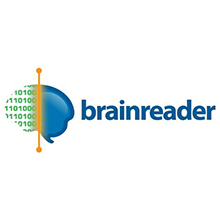20 October 2015

Study, Published in Journal of Alzheimer’s Disease, Highlights Software’s Role in Tracking Key “Vital Sign” for Brain Health
Horsens, Denmark / Milwaukee, Wis. – A new neuroimaging software, Neuroreader, was shown to be as accurate as traditional methods for detecting the slightest changes in brain volume, and does so in a fraction of the time, according to a research study published in the Journal of Alzheimer’s Disease this month. The research validates the software program that can be used for measuring hippocampal volume, a biomarker for detecting Alzheimer’s Disease.
The study, which was conducted earlier this year by a team of 10 researchers, neurologists, radiologists and other healthcare professionals, representing six different organizations, sought to test the accuracy and speed of the Neuroreader software in detecting changes in brain volume on MRIs. Neuroreader, a product of Denmark-based medical technology company Brainreader, is a U.S. Food and Drug Administration-cleared software program for assessment of clinical volume on brain MRIs.
Titled, “Quantitative Neuroimaging Software for Clinical Assessment of Hippocampal Volumes on MR Imaging,” the research was performed independently in Denmark and at the Medical College of Wisconsin, with both studies producing similar results. One of the study’s lead authors and the inventor of Neuroreader, Dr. Jamila Ahdidan, conducted a study at her Brainreader labs, while Edgar A. DeYoe, PhD, a professor in the Department of Radiology at the Medical College of Wisconsin, replicated the study independently in his facility.
Research compared the results of 1.5 T and 3.0 T MRI scans processed by Neuroreader with those which were traced manually by expert anatomists and radiologists. Prior to the onset of neuroimaging software, manual tracing has been the “gold standard” -- the most accurate method -- used among healthcare professionals.
Measuring the level of spatial overlap between Neuroreader and “gold standard” manual segmentation, Neuroreader was on average more than 87% accurate in its agreement with the gold standard method, but could accomplish this task in a fraction of the time – in about 5 minutes per scan compared to 30 minutes for manual segmentation.
The study’s results indicate that neuroimaging software, because it allows radiologists to quickly detect subtle changes in brain volumes, can be a vital tool in the early diagnosis of Alzheimer’s and other degenerative brain diseases.
“For more than 30 years, since the development of the Magnetic Resonance Imaging scanner, the MRI has been the go-to test equipment to find abnormalities in brain volume, which provides strong indication of brain trauma or disease,” said Dr. Oscar Lopez, of the University of Pittsburgh’s Department of Neurology. “Neuroreader adds value to any MRI scanner by providing fast and accurate measurements of brain structure.”
David Merrill, a geriatric psychiatrist at UCLA said, “In applying Neuroreader to my patients with memory loss what I find it most useful for is helping me understand which patients do not have Alzheimer’s. Many persons with psychiatric disorders but not Alzheimer’s have cognitive problems.”
Dr. Dale E. Bredesen, Professor of Neurology at UCLA and founding President and CEO of the Buck Institute for Research on Aging, said, “Regional brain volumes are critical, not only for identifying and differentiating neurodegenerative processes such as Alzheimer’s disease, but also for documenting successful therapeutic approaches.”
According to John L. Ulmer, MD, Director of Neuroradiology at the Medical College of Wisconsin, “People at risk for Alzheimer’s dementia need to know their hippocampal volumes as an important number – just as someone at risk for a heart attack would need to know their cholesterol count.”
Contact: Bob Zeitlinger
bzeitlinger@fireworksbydesign.com
Fireworks PR / Office: 201-244-1213
ABOUT BRAINREADER
Brainreader (http://www.brainreader.net), based in Horsens, Denmark, is a medical device creator and service company at the forefront of the emerging field of brain volumetrics. The company's flagship Neuroreader™ is a novel software tool that facilitates prompt and accurate brain volume assessment.
The Neuroreader, which is sold as software-as-a-service, is available to hospitals’ radiology and neuroradiology departments on a pay-per-use or subscription model tailored to the healthcare organization's wishes. Neuroreader analyzes MRI scans of patients' brains and benchmarks them against a Food & Drug Administration-cleared database of healthy brain tissues in a matter of minutes. Neuroreader is the only service of its kind to have received FDA clearance for its normative database and for the statistical calculations resulting from comparing the measured volumes to that database. The software measures 45 specific structures within the brain.







